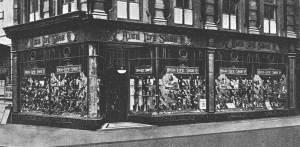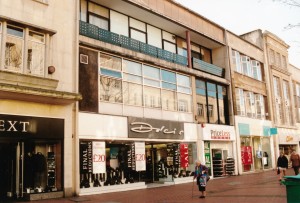
Oxford Street, London, 2000
Some of the most adventurous and exciting shoe shops of the 20th century – and especially of the 1950s – belonged to Dolcis. Once ubiquitous but ultimately ephemeral, scant trace of these can be found on the present-day high street.
This high-street chain of women’s fashion footwear was started in 1863 by John Upson, a bootmaker living in Plumstead, Kent. Upson sold (and here my spell checker is insistently suggesting ‘soled’) shoes in Woolwich market before opening his first shop with the slogan ‘The Great Boot Provider’. By the early 20th century the company had numerous branches throughout London and south-east England, trading simply as Upson’s.
Upson’s became a public company in 1920 and acquired Barron & Co. (with 24 shops trading under that name) in 1925. The head office stood on Great Dover Street in Southwark. By 1927 the company had 135 shops trading under the names Dolcis, Barron & Co., the London Boot Co., Upson & Co., and the High Life Shoe Co. No fewer than nine of the group’s branches were sited on London’s Oxford Street, which had an extraordinary concentration of shoe shops.

A High Life shoe shop, c.1920

Strand, 1920s
The exact origin of the name ‘Dolcis’, which is thought to be Swiss, is uncertain. Historical photographs show that Dolcis shops of the 1920s (like those of High Life, above) were ornate affairs, in a rather traditional Edwardian style. The Charing Cross branch, for example, had expensively curved display windows with ornate transom lights incorporating a ‘DS’ monogram. A glimpse of the branch close to the Savoy Hotel on the Strand (left) in the late 1920s reveals a more modern approach, with illuminated lettering.
In 1931 Upson’s announced: ‘We have adopted a modern and distinctive type of front which has been most successful and is making a very marked impression on the shopping public. The latest examples are the new fronts which have just been installed at The High Life Shoe Stores at 146-148 Oxford-street, and 368-370 Oxford-street, W.1, and the Dolcis fronts at Victoria, Kingston, and elsewhere.’ (from The Times, 20 March 1931, 24). It is intriguing that a similar aesthetic was being applied across more than one brand within the group. The style was art deco, involving geometric display windows, grilles, lights and doors, with bold neonised lettering.

A Dolcis shopfront executed by Holttum & Green, shopfitters, c.1933

Stratford Court, with Dolcis on the ground floor, built in 1936 and photographed in the 1960s.
One of the most important Dolcis outlets of the 1930s opened in 1936 on the lower floors of Stratford Court, a new block of flats (and later a hotel) at 350 Oxford Street. The architects of this tall red-brick neo-Georgian building – Gunton & Gunton – worked alongside Dolcis’s staff architect, Harry Simcock. This was one of the first shops in London to take advantage of new rules which permitted a projecting canopy, a feature which has since been removed. As at other Dolcis shops of the 1930s (such as Brixton in 1937) the shopfront made use of shiny ‘Staybrite’ steel. It had an extensive arcade: a deep lobby with no fewer than six freestanding or ‘island’ showcases. At the heart of the shop was a dramatic staircase with a sweeping silver-bronze balustrade and ebonised handrail. The floor, throughout, was thickly carpeted in a bold geometric design. The shop is now occupied by Disney.
Ellis E. Somake (1908-1998) was appointed the staff architect to Dolcis in 1948 and oversaw the post-war expansion of the chain. His brief was to produce ‘an entirely new look to their new and refurbished shops, making them the most up-to-date vehicle for the sale of FASHION shoes . . . with the architecture and interior design to reflect this’ (Somake’s own words, in a letter dated 6 June 1985). So long as they kept within budget, Somake and his assistants – including R. W. Freeborn and Geoffrey H. Uffindell – could ‘hatch and implement our own ideas both in regard to the shopfront and fascia design, the interior planning and decoration, and in the case of an open site, the design of the building as well’. Reflecting this, Somake’s team worked with different shopfitters from job to job, though some specialist contractors were employed consistently: Minter, for example, invariably supplied Dolcis carpets.

Dolcis, Old Bond Street, photographed by E. Hyman (from E. E. Somake & Rolf Hellberg, Shops & Stores of Today, London, 1956, 147).
Each new Dolcis project of the early-to-mid 1950s was unique. Nevertheless, some generalisations can be drawn to show how the shops had evolved to embrace modern ideas and technologies. The vast ‘arcade’ entrances of the pre-war period shrank in size and shopfronts became transparent, with armour-plated glass doors set in all-glass fronts. Entrance lobbies could still be vast, but they were no longer interrupted by island display cases. Interiors were typically given false ceilings of ‘egg-crate’ or fibrous plaster – often painted blue – set with combinations of spotlights and recessed or troughed lighting. Walls were often clad in vertical timber boarding. Staircases had a light quality with open treads and glass balustrades. Terrazzo or mosaic floors were partially covered by patterned carpeting, and sales rooms were furnished with contemporary-style seating – usually armchairs with spindly tapered legs and colourful upholstery. Shoe displays adopted quirky geometric or amorphous shapes.

Man’s Shop, Oxford Street, photographed by Edgar Hyman (from E. E. Somake & Rolf Hellberg, Shops & Stores of Today, London, 1956, 71).
Perhaps most radical of all, many new branches included a ‘man’s shop’ as well as a ‘ladies’ department’ or ‘ladies’ salon’ (never called a ‘woman’s shop’). In 1950 Dolcis opened an experimental shop exclusively for men at 55-59 Oxford Street, on the corner of Soho Street in London. This occupied two floors of the building, with the main sales space in the basement. This adopted a nautical ‘below decks’ character, with a low, boarded ceiling. The displays made much use of pegboard – a ubiquitous material in the later 1950s and early 1960s – and part of the ground floor was laid with random (although not truly ‘crazy’) paving. In the same year, the pre-war window display lobby of the branch in Leicester Square was remodelled as a man’s shop. Slatted screens gave this a sense of separateness and enclosure. While the man’s shop adopted a rectilinear aesthetic, the ladies’ department on the upper floor was softly curvaceous, with serpentine displays surrounding the seating area.
Surprisingly, these highly modern shoe shops were still fitted with Lamson pneumatic tubes rather than cash registers, but the man’s shop on Oxford Street included a special ‘cheque table’.

Staircase, Coventry, photographed by Edgar Hyman (from E. E. Somake & Rolf Hellberg, Shops & Stores of Today, London, 1956, 83).
In 1951 Dolcis opened a shop in the new Dingles block in Plymouth, where the pre-war shop had been destroyed by bombing. Upstairs was a ‘children’s corner’ with imitation railway carriages and a specially commissioned mural of an English seaside scene with children on holiday . Up on the second floor – daringly distant from the street in days before escalators became common – was the main ladies’ department. According to Jeremy Gould, writing in Plymouth: Vision of a Modern City, this shop ‘gave Plymothians their first glimpse of the contemporary modern style of the Festival of Britain’.
Another bombed outlet was replaced in Coventry a few years later, in 1955. The shop occupied the corner of British Home Stores at the junction of the Lower and Upper Precincts. The canopy – now a ubiquitous feature of retail buildings – was pierced at the back to allow the two-tier shopfront to rise through it. By now Dolcis had developed a penchant for dark veined marble: as well as being used to frame shopfronts (for example on Old Bond Street), it was sometimes used, as here, to clad the back of stair bays. Intriguingly, this building was supposedly planned on an 11 ft. grid ‘this being the correct distance between chairs in a shoe shop’ (from The Architect & Building News, 5 May 1955, 535).

Dolcis, Oxford Street, 1950s. c. Historic England
In June 1956 Dolcis opened yet another a branch on Oxford Street, on the site of Flemings Restaurant, near Woolworth’s flagship store. On the marble fascia the Dolcis name – with a trademark insignia created by the designer Reynolds Stone – was followed by the slogan ‘the world of fashion at your feet’. The first-floor windows were screened by a grille fitted with a geometric pattern of red and white neon tubing superimposed with Perspex letters spelling out the name. Inside, the mosaic floors echoed the pattern of the fascia grille, while the carpets were woven with the Dolcis insignia. One of the main features to the front of the shop was the lighting: a combination of spotlights and soffit lighting, hidden within honeycomb coffering coloured red, yellow and grey.
In 1956 Upson’s, recently renamed Dolcis, was absorbed by the British Shoe Corporation. According to Somake, the priority for the shops became ‘more financial than aesthetic . . . The design and construction of interiors in particular could now be likened to exhibition stand work, or almost to stage settings’.

Dolcis, Bristol, 1999
Soon afterwards, in 1958, the first self-service Dolcis shoe shop opened at 333 Oxford Street. Traditional service was retained in the basement and in the men’s shop, but part of the ground floor was remodelled with tiered display stands and rather uncomfortable-looking ‘poufe-type seats’. It was explained: ‘The only personal assistance given is the supply of the accompanying shoe on request, and with the sale’ (The Architect & Building News, 3 December 1958) – just how we still buy shoes in most shoe shops today. The shopfitting, unfortunately, became more perfunctory though some pre-war ‘arcade’ fronts survived well into the 1970s.
The Dolcis headquarters relocated to Leicester in 1967. Somake retired in 1970 and emigrated to Canada. Later developments in the shopfitting activities of the chain are difficult to track, but a scheme trialled in Leicester in 1996 was, bizarrely, inspired by French bistros.

Dolcis, Halifax, 2000

Dolcis, Bedford, 1999
Dolcis was bought by Alexon in 1998 and moved to Luton. The still-familiar signature logo replaced older lettering on fascias. In 2006 Dolcis was sold (with, at that time, 65 shops plus 150 concessions in Envy and Bay Trader) to John Kinnaird. In January 2008 it fell into administration. The Dolcis name and 24 of the remaining 185 shops and concessions were bought by the Stylo Group, owners of Barratt’s. When Barratt Priceless collapsed into administration in 2012 – one of its many setbacks – Dolcis was acquired by the Jacobsen Group. It has traded online since 2013, but no longer has a physical presence in British shopping centres. A red signature logo can still be seen over Dolcis shops in the Netherlands but may soon vanish – its owners, the Macintosh Group, were declared bankrupt in December 2015.

Greenwich Industrial History has just published this on their blog http://greenwichindustrialhistory.blogspot.co.uk/2017/07/plumstead-and-origins-of-dolcis-shoes.html
LikeLike
Dear Kathryn,
I am enquiring about the Historic England image of Dolcis, c1950s. I have emailed Historic England about the image and they are unable to locate it on their database. Do you know where you found the image?
My contact details are: sophiapatel.95@googlemail.com
Best wishes,
Sophia Patel
LikeLike